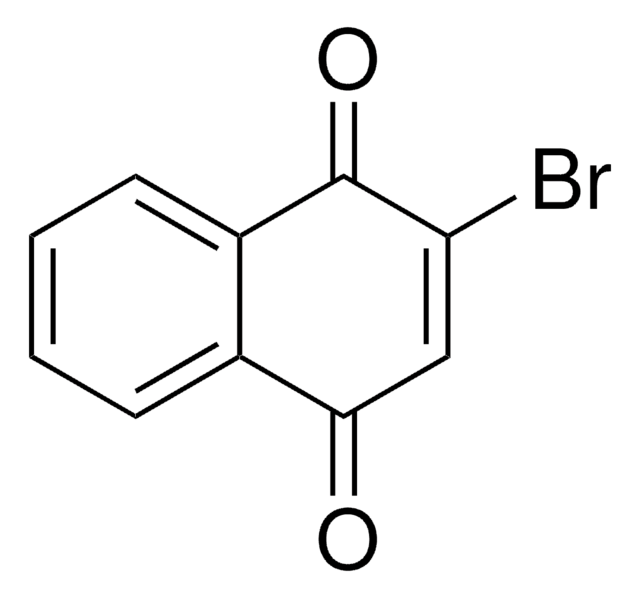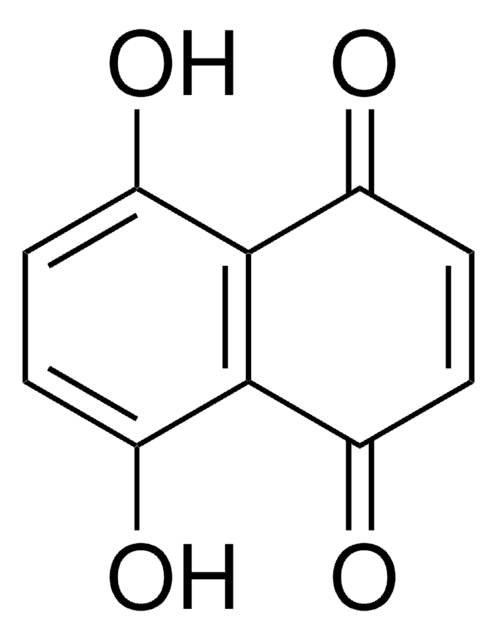All Photos(1)
About This Item
Empirical Formula (Hill Notation):
C11H8O3
CAS Number:
Molecular Weight:
188.18
MDL number:
UNSPSC Code:
12352100
PubChem Substance ID:
NACRES:
NA.22
Recommended Products
Assay
98%
mp
184-187 °C (lit.)
SMILES string
COC1=CC(=O)c2ccccc2C1=O
InChI
1S/C11H8O3/c1-14-10-6-9(12)7-4-2-3-5-8(7)11(10)13/h2-6H,1H3
InChI key
OBGBGHKYJAOXRR-UHFFFAOYSA-N
Related Categories
General description
2-Methoxy-1,4-naphthoquinone is a potential candidate for Helicobacter pylori infection related disease therapy. It is isolated from the leaves of Impatiens glandulifera.
Application
2-Methoxy-1,4-naphthoquinone was used in the preparation of 2-(4-X-phenylene)amine-1,4-naphthoquinones (X= ferrocenyl, OMe, Me, I, Cl and NO2).
Signal Word
Warning
Hazard Statements
Precautionary Statements
Hazard Classifications
Eye Irrit. 2 - Skin Irrit. 2 - STOT SE 3
Target Organs
Respiratory system
Storage Class Code
11 - Combustible Solids
WGK
WGK 3
Flash Point(F)
Not applicable
Flash Point(C)
Not applicable
Personal Protective Equipment
dust mask type N95 (US), Eyeshields, Gloves
Certificates of Analysis (COA)
Search for Certificates of Analysis (COA) by entering the products Lot/Batch Number. Lot and Batch Numbers can be found on a product’s label following the words ‘Lot’ or ‘Batch’.
Already Own This Product?
Find documentation for the products that you have recently purchased in the Document Library.
Customers Also Viewed
General method for the high yield preparation of 2-(4-X-phenylene) amine-1, 4-naphthoquinones (X= ferrocenyl, OMe, Me, I, Cl, and NO2) from 2-methoxy-1, 4-naphthoquinone and investigation of H+ and Mg2+ catalysts with DFT calculations.
Francisco AI, et al.
Journal of Molecular Structure, 891(1), 228-232 (2008)
Aldana L Zalazar et al.
Food research international (Ottawa, Ont.), 116, 916-924 (2019-02-06)
Probabilistic microbial modelling using logistic regression was used to predict the growth/no growth (G/NG) interfaces of Zygosaccharomyces bailii in simulated acid sauces as a function of natamycin, xanthan gum (XG) and sodium chloride concentrations. The growth was assessed colorimetrically by
Scott B Vafai et al.
PloS one, 11(9), e0162686-e0162686 (2016-09-14)
Deficiency of mitochondrial complex I is encountered in both rare and common diseases, but we have limited therapeutic options to treat this lesion to the oxidative phosphorylation system (OXPHOS). Idebenone and menadione are redox-active molecules capable of rescuing OXPHOS activity
K Ishiguro et al.
Journal of natural products, 61(9), 1126-1129 (1998-09-28)
Dinaphthofuran-7,12-dione derivatives named balsaminones A (1) and B (2) were isolated from the pericarp of Impatiens balsamina L. together with the known compound 2-methoxy-1,4-naphthoquinone (3). Their structures were elucidated by spectral techniques. These compounds have significant antipruritic activity.
M Chen et al.
Scientific reports, 10(1), 951-951 (2020-01-24)
Olfactory ensheathing cells (OECs) are crucial for promoting the regeneration of the primary olfactory nervous system that occurs throughout life. Transplantation of OECs has emerged as a promising therapy for nervous system injuries, in particular for spinal cord injury repair.
Our team of scientists has experience in all areas of research including Life Science, Material Science, Chemical Synthesis, Chromatography, Analytical and many others.
Contact Technical Service











